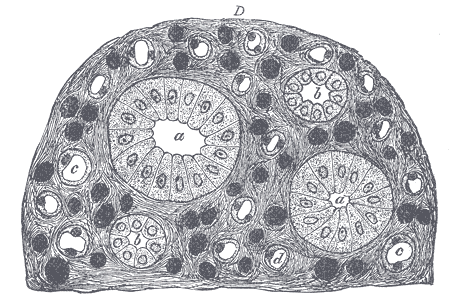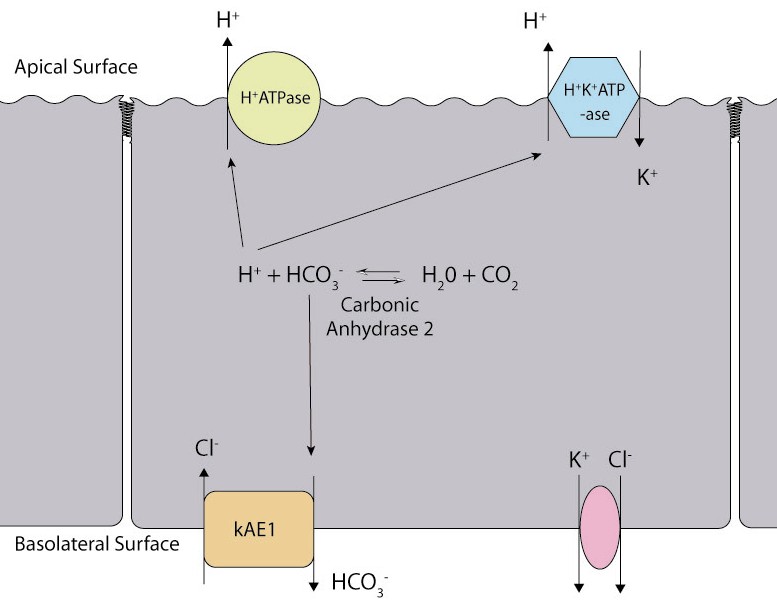Collecting duct system
Editor-In-Chief: C. Michael Gibson, M.S., M.D. [1]
The collecting duct system of the kidney consists of a series of tubules and ducts that connect the nephrons to the ureter. It participates in electrolyte and fluid balance through reabsorption and excretion, processes regulated by the hormones aldosterone and antidiuretic hormone.
Anatomically, there are several components of the collecting duct system, including the connecting tubules, cortical collecting ducts, and medullary collecting ducts.
Function
The collecting duct system is the last component of the kidney to influence the body's electrolyte and fluid balance. In humans, the system accounts for 4-5% of the kidney's reabsorption of sodium and 5% of the kidney's reabsorption of water. At times of extreme dehydration, over 24% of the filtered water may be reabsorbed in the collecting duct system.
The wide variation in water reabsorption levels for the collecting duct system reflects its dependence on hormonal activation. The collecting ducts, particularly the outer medullary and cortical collecting ducts, are largely impermeable to water without the presence of antidiuretic hormone (ADH, or vasopressin).
- In the absence of ADH, water in the renal filtrate is left alone to enter the urine, promoting diuresis.
- When ADH is present, aquaporins allow for the reabsorption of this water, thereby inhibiting diuresis.
The collecting duct system participates in the regulation of other electrolytes, including chloride, potassium, hydrogen ions, and bicarbonate.
Anatomy
The parts of the system are as follows:
| connecting tubule | With respect to the renal corpuscle, the "connecting tubule" is the most proximal part of the collecting duct system. It is adjacent to the distal convoluted tubule, the most distal segment of the renal tubule. Connecting tubules from several adjacent nephrons merge to form cortical collecting tubules, and these may join to form cortical collecting ducts. Connecting tubules of some juxtamedullary nephrons may arch upward, forming an arcade. |
| cortical collecting ducts | The "cortical collecting ducts" receive filtrate from multiple connecting tubules and descend into the renal medulla to form medullary collecting ducts. |
| medullary collecting ducts | "Medullary collecting ducts" are divided into outer and inner segments, the latter reaching more deeply into the medulla. The variable reabsorption of water and, depending on fluid balances and hormonal influences, the reabsorption or secretion of sodium, potassium, hydrogen and bicarbonate ion continues here. |
| papillary ducts, also known as duct of Bellini | The terminal portions of the medullary collecting ducts are the "papillary ducts", which end at the renal papilla and empty into a minor calyx. |
The connecting tubule derives from the metanephric blastema, but the rest of the system derives from the ureteric bud. Because of this, some sources group the connecting tubule as part of the nephron, rather than grouping it with the collecting duct system.
Cell types
Each component of the collecting duct system contains two cell types, intercalated cells and a segment-specific cell type:
- For the connecting tubules, this specific cell type is the connecting tubule cell
- For the collecting ducts, it is the principal cell. The inner medullary collecting ducts contain an additional cell type, called the inner medullary collecting duct cell.
Principal cells
The principal cell mediates the collecting duct's influence on sodium and potassium balance via sodium channels and potassium channels located on the cell's apical membrane. Aldosterone determines if the sodium channels transport ions.[1]
Intercalated cells
Intercalated cells come in α and β varieties and participate in acid-base homeostasis.
| Type of cell | Secretes | Reabsorbs |
| α-intercalated cells[2] | acid (via an apical H+-ATPase and H+/K+ exchanger) in the form of hydrogen ions | bicarbonate (via band 3, a basolateral Cl-/HCO3- exchanger) |
| β-intercalated cells | bicarbonate (via pendrin a specialised apical Cl-/HCO3-) | acid (via a basal H+-ATPase) |
For their contribution to acid-base homeostasis, the intercalated cells play important roles in the kidney's response to acidosis and alkalosis. Damage to the α-intercalated cell's ability to secrete acid can result in distal renal tubular acidosis (RTA type I, classical RTA).
Additional images
-
Transverse section of pyramidal substance of kidney of pig, the bloodvessels of which are injected.
-
Alpha intercalated cell cartoon
References
- Eaton, Douglas C., Pooler, John P. (2004). Vander's Renal Physiology (6 ed.). Lange Medical Books/McGraw-Hill. ISBN 0-07-135728-9.
External links
- Histology at KUMC epithel-epith04 "Collecting Duct (Kidney)"
- Histology image: 15803loa – Histology Learning System at Boston University - "Urinary System: kidney, medulla, collecting duct and ascending tubule"
- Histology image: 16013loa – Histology Learning System at Boston University - "Urinary System: kidney, H&E, collecting duct and ascending tubule"

